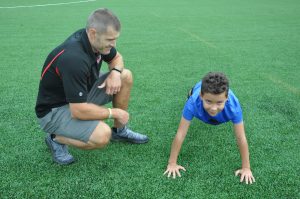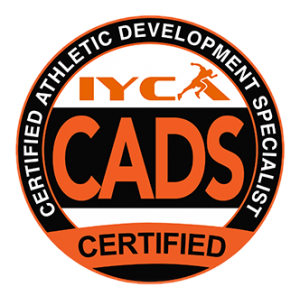The IYCA has produced hundreds of articles and dozens of courses/certifications on important topics related to training young athletes. There is a lot to know and understand about long term athlete development (LTAD) and creating exceptional training experiences for young athletes. While it’s impossible to have a full understanding of everything involved in this process, this article boils it down into the Top 10 tips for training young athletes.
Whether you’re a trainer, coach, administrator or parent, this list will give you a basic understanding of the most important concepts involved in training young athletes.

1. Progress over Performance: Focusing on wins and losses is like fools gold. You may have won the game or race, but that doesn’t mean you made progress or performed your best. Celebrate progress rather than performance. Have a plan and goal for training, and don’t let unimportant competitions get in the way of sticking to the plan. For young athletes, competitions should be viewed as opportunities to use what has been worked on in practice rather than judging who is good or bad.
2. Think Long-Term: Rather than taking shortcuts to see some short-term success, build a strong foundation that will allow an athlete to build upon. Young athletes need to develop fundamental motor skills, coordination and all-around athleticism that will enable them to perfect sports skills later in their development. Athletic development takes time and can’t be rushed. The goal shouldn’t be winning the game this weekend. Instead, build athletic qualities that will allow for continued growth.
3. Balance General & Specific: Many coaches want to focus exclusively on one sport or event in order to achieve early success. While this may help children perform well at a young age, you cannot go back and develop foundational skills like coordination and motor control once the window has closed. While sports skills certainly need to be taught, be sure to include “general athleticism” drills when training young athletes to build a stronger capacity to learn and perfect skills later. These two concepts should not be mutually exclusive. It’s absolutely possible to use the warm-up period to enhance athleticism by including fundamental motor skills, plyometrics, coordination activities, strength development, and mobility work.

4. Ignite a Fire & Develop Confidence: The goals of every youth sports coach should always be to inspire a desire to excel and to keep kids coming back for more. Give them examples of what they can be by introducing them to older athletes, taking them to events, and painting mental images of what their future may hold. Get them to see where they could be someday. Keep dreams alive in every child until they decide to move on. Many athletes mature late, and just need to stay with a sport long enough for their strength, size, and power to develop.
5. Teach Young Athletes More Than Sports: Sports are metaphors for life. Use sports to teach lessons about the value of hard work, listening, cooperation, repetition, and other life skills. If all you focus on is the sport, you are missing an opportunity to make a much larger impact on a young athlete.
6. Focus on the Nervous System: While young athletes can improve strength and endurance, their hormones and anaerobic energy systems are not fully developed yet, so they will not see major improvements in muscular size or anaerobic capacity until adolescence. Before that time, focus on developing the nervous system by training technique, coordination and fundamental abilities like balance and kinesthetic awareness. Gradually change the focus over time as the athlete matures.
7. Balance Variety & Repetition: Variety is an excellent way to stimulate the developing nervous system, but repetition will develop technique. Young athletes need both and should be taught the value of repetition and the enjoyment of variety.
8. Basic Scientific Principles Apply: The two most important scientific training principles to understand when training young athletes are Systematic Progression and Specific Adaptations to Imposed Demands (S.A.I.D. Principle). The S.A.I.D. Principle states that the body will adapt very specifically to the stimulus it encounters. In other words, we get better at what we practice. For example, if we want to increase strength, we must consistently put the muscle under tension with intensity. It will respond by adding more protein strands which will eventually manifest as a stronger, larger muscle. On the other hand, performing low intensity, high volume exercises will increase muscular endurance rather than muscular strength. Both are good, but you need to understand the goal before you choose the training method.

Systematic Progression is the concept of systematically increasing the demands placed upon the athlete in order to stimulate constant adaptation. As a very simple example, if an athlete wants to increase her pull-up strength, and can currently do 5 pull-ups, she should eventually strive to get 6 reps. When six reps are achieved, she should try to do 7 reps. This is a very basic example, but the point is that athletes should constantly be challenged to do that which they are not currently able to do. This concept holds true for all physical attributes.
9. Slight Overreach: This concept works hand-in-hand with Systematic Progression, but can include practices and competitions as well. The idea is to push athletes barely out of their comfort zone – both in training and competition. Have them compete against opponents that are slightly better than them so they are always striving to improve. Be very careful not to put them in too many situations that are completely out of their reach as this often leads to frustration and decreased self-esteem. It’s also important for young athletes to feel successful, so give them opportunities to succeed as well. There should be a healthy balance between a young athlete feeling confident and knowing he/she can improve. Great coaches are able to keep confidence high while helping the athlete work toward larger goals.
10. Use Volume, Don’t Abuse It: The volume (or amount) of work is one of the most misunderstood concepts in athlete development, and it can be highly individualized. A volume of work that is too low will not elicit progress. On the other hand, a very high volume of work is often unnecessary and leads to injuries, boredom, and burnout. An athletes biological age, training age, genetics, nutrition, sleep patterns, and outside activities are all factors in how much volume is appropriate. Coaches and parents need to constantly monitor a young athlete’s physical, mental and emotional well-being, and be prepared to make adjustments at any time.
These 10 tips provide an overview of the most important concepts to understand when training young athletes. For more in-depth information on the concepts and specifics on how to implement them, the IYCA encourages you to go through the Certified Athletic Development Specialist, which is the gold-standard certification for anyone working with athletes 6-18 years old. The course materials were created by some of the most experienced and knowledgeable professionals in the industry, and the content is indisputably the most comprehensive of any certification related to athletic development. Learn more about the CADS certification here:

 Jim Kielbaso
Jim Kielbaso is the President of the IYCA and Owner of Impact Sports Performance in Michigan. He has authored multiple books, articles and training products and has spoken at events around the world. He holds a BS in Exercise Science, an MS in Kinesiology and has gone through multiple certifications through the IYCA, NSCA, NASM and more. Jim is a former college strength & conditioning coach and has trained thousands of athletes at every level of competition. He runs a successful
NFL Combine training program in Michigan and has been hired as a consultant for major sports programs like the University of Michigan Football Program and the University of Kentucky Basketball Program.



 Jim Kielbaso is the President of the IYCA and Owner of Impact Sports Performance in Michigan. He has authored multiple books, articles and training products and has spoken at events around the world. He holds a BS in Exercise Science, an MS in Kinesiology and has gone through multiple certifications through the IYCA, NSCA, NASM and more. Jim is a former college strength & conditioning coach and has trained thousands of athletes at every level of competition. He runs a successful NFL Combine training program in Michigan and has been hired as a consultant for major sports programs like the University of Michigan Football Program and the University of Kentucky Basketball Program.
Jim Kielbaso is the President of the IYCA and Owner of Impact Sports Performance in Michigan. He has authored multiple books, articles and training products and has spoken at events around the world. He holds a BS in Exercise Science, an MS in Kinesiology and has gone through multiple certifications through the IYCA, NSCA, NASM and more. Jim is a former college strength & conditioning coach and has trained thousands of athletes at every level of competition. He runs a successful NFL Combine training program in Michigan and has been hired as a consultant for major sports programs like the University of Michigan Football Program and the University of Kentucky Basketball Program.

